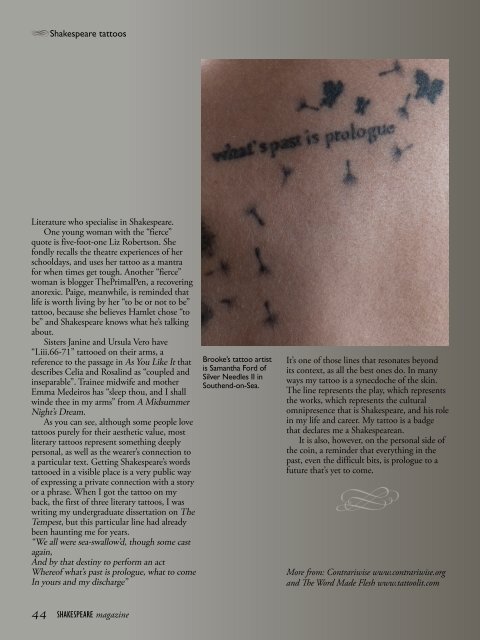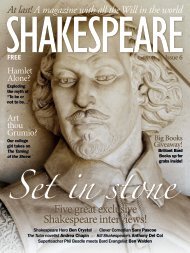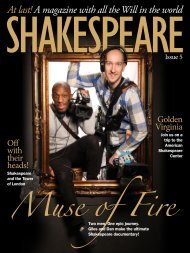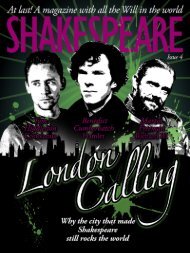Shakespeare Magazine 02
The second issue of Shakespeare Magazine features a wealth of wonders from the world of William Shakespeare. Highlights include David Tennant fans sharing their Shakespeare, Hamlet restaged with toys, Shakespeare in Sydney, and the enduring romance of Shakespeare and classical music. Plus much more!
The second issue of Shakespeare Magazine features a wealth of wonders from the world of William Shakespeare. Highlights include David Tennant fans sharing their Shakespeare, Hamlet restaged with toys, Shakespeare in Sydney, and the enduring romance of Shakespeare and classical music. Plus much more!
Create successful ePaper yourself
Turn your PDF publications into a flip-book with our unique Google optimized e-Paper software.
<strong>Shakespeare</strong> tattoos<br />
Brooke’s<br />
Literature who specialise in <strong>Shakespeare</strong>.<br />
One young woman with the “fierce”<br />
quote is five-foot-one Liz Robertson. She<br />
fondly recalls the theatre experiences of her<br />
schooldays, and uses her tattoo as a mantra<br />
for when times get tough. Another “fierce”<br />
woman is blogger ThePrimalPen, a recovering<br />
anorexic. Paige, meanwhile, is reminded that<br />
life is worth living by her “to be or not to be”<br />
tattoo, because she believes Hamlet chose “to<br />
be” and <strong>Shakespeare</strong> knows what he’s talking<br />
about.<br />
Sisters Janine and Ursula Vero have<br />
“I.iii.66-71” tattooed on their arms, a<br />
reference to the passage in As You Like It that<br />
describes Celia and Rosalind as “coupled and<br />
inseparable”. Trainee midwife and mother<br />
Emma Medeiros has “sleep thou, and I shall<br />
winde thee in my arms” from A Midsummer<br />
Night’s Dream.<br />
As you can see, although some people love<br />
tattoos purely for their aesthetic value, most<br />
literary tattoos represent something deeply<br />
personal, as well as the wearer’s connection to<br />
a particular text. Getting <strong>Shakespeare</strong>’s words<br />
tattooed in a visible place is a very public way<br />
of expressing a private connection with a story<br />
or a phrase. When I got the tattoo on my<br />
back, the first of three literary tattoos, I was<br />
writing my undergraduate dissertation on The<br />
Tempest, but this particular line had already<br />
been haunting me for years.<br />
“We all were sea-swallow’d, though some cast<br />
again,<br />
And by that destiny to perform an act<br />
Whereof what’s past is prologue, what to come<br />
In yours and my discharge”<br />
tattoo artist<br />
is Samantha Ford of<br />
Silver Needles II in<br />
Southend-on-Sea.<br />
It’s one of those lines that resonates beyond<br />
its context, as all the best ones do. In many<br />
ways my tattoo is a synecdoche of the skin.<br />
The line represents the play, which represents<br />
the works, which represents the cultural<br />
omnipresence that is <strong>Shakespeare</strong>, and his role<br />
in my life and career. My tattoo is a badge<br />
that declares me a <strong>Shakespeare</strong>an.<br />
It is also, however, on the personal side of<br />
the coin, a reminder that everything in the<br />
past, even the difficult bits, is prologue to a<br />
future that’s yet to come.<br />
<br />
More from: Contrariwise www.contrariwise.org<br />
and The Word Made Flesh www.tattoolit.com<br />
44 SHAKESPEARE magazine

















